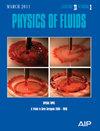基于四维血流磁共振成像和深度学习的血流压力计算方法
IF 4.3
2区 工程技术
Q1 MECHANICS
引用次数: 0
摘要
利用人工智能方法进行血流压力估算可显著提高血流压力的计算速度。然而,目前的相关研究只能计算固定边界条件下不同几何形状血管的血流压力参数,无法实现瞬态流场计算,也无法考虑患者不同生理和病理情况下形成的血流动力学差异。有鉴于此,本研究提出了一种基于患者血流的四维血流磁共振成像(4D flow MRI)和深度学习的相对压力估算方法。利用四维血流磁共振成像获取患者的血流速度梯度数据,并对采样数据进行特征工程处理。然后,提出了一种新型神经网络,以获取待测点附近和相邻采样时间段内速度梯度与压力梯度之间的特征关系,从而实现待测点附近相对压力的计算。该方法与计算流体动力学方法和导管压力测量技术进行了比较,并进行了统计分析,以评估其有效性。建议方法的准确率超过 96%,计算效率提高了几十倍,而且无需手动设置生理参数。此外,将计算结果与临床导管测压结果进行比较,r2 = 0.9053,表明两种方法具有显著的一致性。与之前的研究相比,本研究提出的方法可以通过四维血流磁共振成像将不同患者不同时间的血流速度情况作为输入特征,从而实现瞬态流场中的压力计算,在保持较高计算精度的同时,显著提高了计算效率,降低了成本。这为未来血流压力的机器学习预测研究提供了新的方向。本文章由计算机程序翻译,如有差异,请以英文原文为准。
The calculation method of blood flow pressure based on four-dimensional flow magnetic resonance imaging and deep learning
Utilizing artificial intelligence methods for blood flow pressure estimation can significantly enhance the computational speed of blood flow pressure. However, current related research can only calculate the blood flow pressure parameters of vessels with different geometric shapes under fixed boundary conditions, thus fail to achieve transient flow field calculation and consider the hemodynamic differences formed by patients' varying physiological and pathological conditions. In view of this, this study proposes a method for relative pressure estimation based on four-dimensional flow magnetic resonance imaging (4D flow MRI) of patient blood flow and deep learning. 4D flow MRI was used to obtain the patient's blood flow velocity gradient data, and feature engineering processing is performed on the sampled data. Then, a novel neural network was proposed to acquire the characteristic relationship between velocity gradient and pressure gradient in the vicinity of the point to be measured and within adjacent sampling time periods, thereby achieving the calculation of the relative pressure in the vicinity of the point to be measured. Statistical analysis was performed to evaluate the efficacy of the method, comparing it with computational fluid dynamics methods and catheter pressure measurement techniques. The accuracy of the proposed method exceeded 96%, while computational efficiency was improved by several tens of times, and no manual setting of physiological parameters was required. Furthermore, the results were compared with clinical catheter-measured pressure results, r2 = 0.9053, indicating a significant consistency between the two methods. Compared to previous research, the method proposed in this study can take the blood flow velocity conditions of different patients at different times as input features via 4D flow MRI, thus enabling the calculation of pressure in transient flow fields, which significantly improved computational efficiency and reduced costs while maintaining a high level of calculation accuracy. This provides new direction for future research on machine learning prediction of blood flow pressure.
求助全文
通过发布文献求助,成功后即可免费获取论文全文。
去求助
来源期刊

Physics of Fluids
物理-力学
CiteScore
6.50
自引率
41.30%
发文量
2063
审稿时长
2.6 months
期刊介绍:
Physics of Fluids (PoF) is a preeminent journal devoted to publishing original theoretical, computational, and experimental contributions to the understanding of the dynamics of gases, liquids, and complex or multiphase fluids. Topics published in PoF are diverse and reflect the most important subjects in fluid dynamics, including, but not limited to:
-Acoustics
-Aerospace and aeronautical flow
-Astrophysical flow
-Biofluid mechanics
-Cavitation and cavitating flows
-Combustion flows
-Complex fluids
-Compressible flow
-Computational fluid dynamics
-Contact lines
-Continuum mechanics
-Convection
-Cryogenic flow
-Droplets
-Electrical and magnetic effects in fluid flow
-Foam, bubble, and film mechanics
-Flow control
-Flow instability and transition
-Flow orientation and anisotropy
-Flows with other transport phenomena
-Flows with complex boundary conditions
-Flow visualization
-Fluid mechanics
-Fluid physical properties
-Fluid–structure interactions
-Free surface flows
-Geophysical flow
-Interfacial flow
-Knudsen flow
-Laminar flow
-Liquid crystals
-Mathematics of fluids
-Micro- and nanofluid mechanics
-Mixing
-Molecular theory
-Nanofluidics
-Particulate, multiphase, and granular flow
-Processing flows
-Relativistic fluid mechanics
-Rotating flows
-Shock wave phenomena
-Soft matter
-Stratified flows
-Supercritical fluids
-Superfluidity
-Thermodynamics of flow systems
-Transonic flow
-Turbulent flow
-Viscous and non-Newtonian flow
-Viscoelasticity
-Vortex dynamics
-Waves
 求助内容:
求助内容: 应助结果提醒方式:
应助结果提醒方式:


